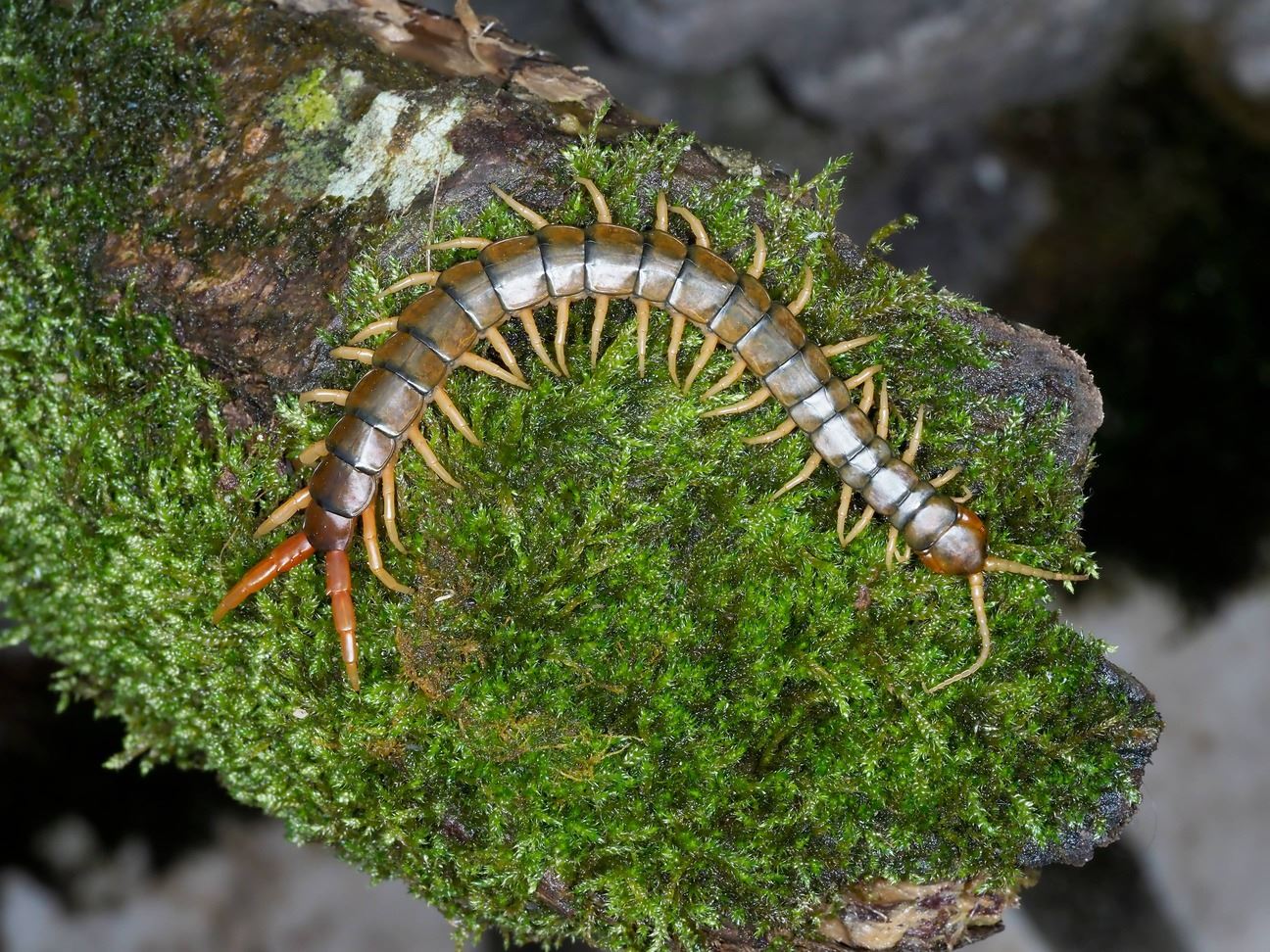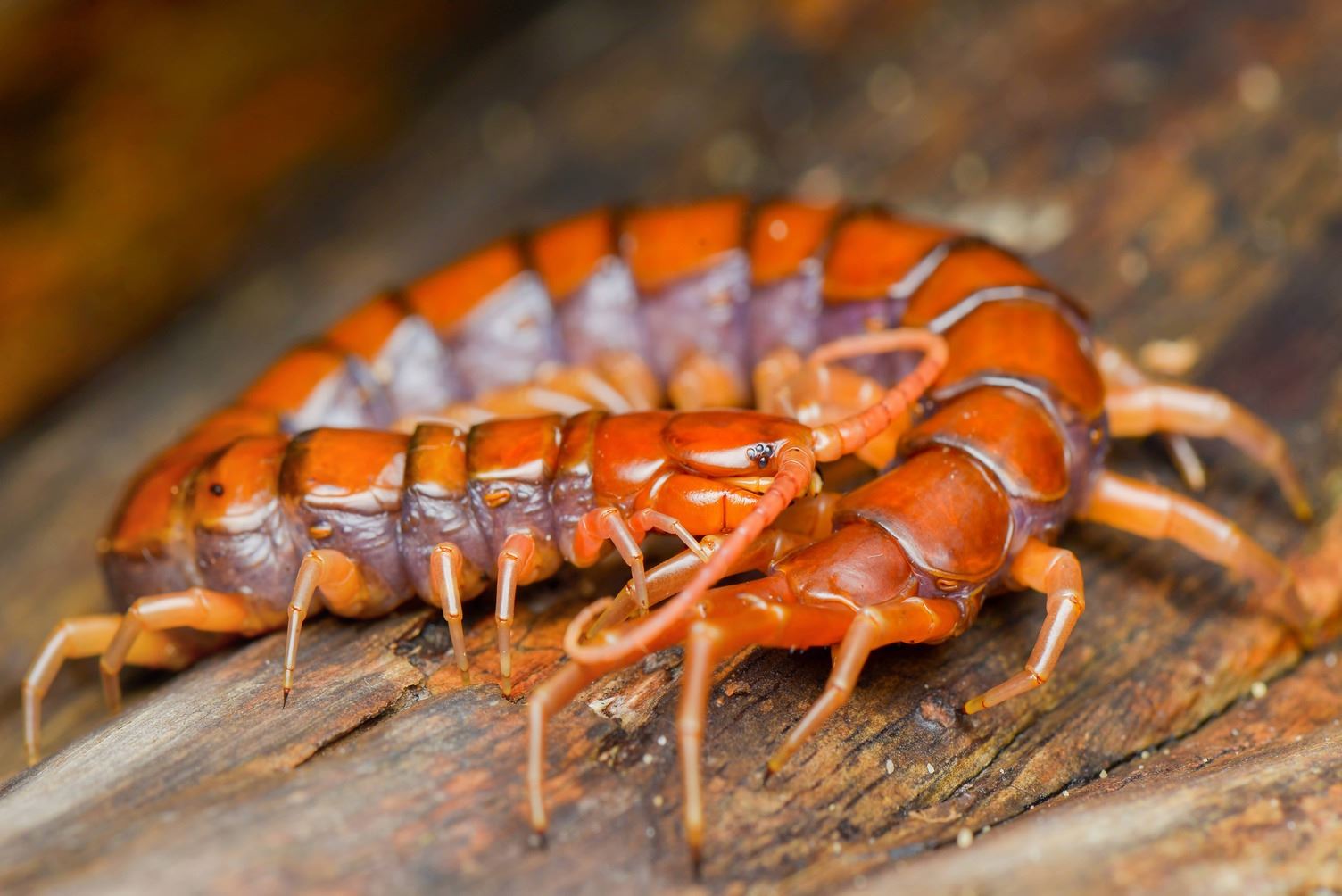Centipedes are fascinating and often misunderstood creatures that play a vital role in the ecosystem. This diverse group of arthropods, with over 8,000 known species, are known for their many legs and segmented bodies. Their adapted anatomy allows them to navigate through various environments with ease. In this article, we’ll explore where we find centipedes, what they eat, their lifecycle, and what can attract them to your home.
Let’s learn more about centipedes!
What is a Centipede?
A centipede is an invertebrate from the class Chilopoda, easily recognized by its elongated, worm-like body and multitude of legs. Each segment of their body bears a single pair of these legs. The number of leg pairs can vary widely among species, contradicting the common belief that they all possess exactly one hundred legs.

Where Do You Find Centipedes?
Centipedes are versatile and can be found across multiple continents, thriving in environments that range from tropical rainforests to arid deserts. They have a preference for moist and sheltered spaces such as under stones, fallen logs, leaf piles, or within soil crevices. Indoors, they may take refuge in basements, bathrooms, and other areas where humidity levels are high.
Are They Harmful or Helpful?
While their appearance might be alarming to some, centipedes are largely beneficial to humans. They act as natural pest controllers by preying on insects that can be harmful to crops and household plants. However, certain larger species can deliver a painful bite if handled or threatened, which can be medically significant to sensitive individuals.
What Do Centipedes Eat?
Centipedes are predatory creatures and their diet consists mainly of insects and other small arthropods. They use their venomous claws just behind their head to paralyze their prey before consuming it. This predatory behavior helps maintain a balanced ecosystem by controlling the populations of other invertebrates.
Centipedes are intriguing creatures with complex behaviors and life cycles that vary across the many species found worldwide. Understanding their mating habits, reproduction, and offspring care can provide a deeper insight into these often misunderstood arthropods.
Behavior and Lifecycle of Centipedes
Mating Habits
In many species, male centipedes perform a courtship dance to attract females. Some species deposit a spermatophore, a capsule or packet of sperm, which the female then picks up. In certain cases, the male directly transfers the spermatophore to the female using his gonopods, specialized appendages for reproductive purposes.
Reproduction
After fertilization, the female centipede lays her eggs in a safe and secluded environment. The number of eggs laid can vary greatly depending on the species, ranging from just a few to over a hundred. Some species exhibit ovoviviparity, where the eggs develop and hatch inside the female’s body, and she gives birth to live young.
Offspring Care
Centipede parental care is quite rare in the invertebrate world but is a notable behavior among some centipede species. For instance, the female may coil around the eggs to protect them from predators and keep them in a moist environment, which is crucial for their development. She may also clean the eggs to prevent fungal growth. After hatching, some mothers continue to guard their young until they are capable of fending for themselves.
The young centipedes, known as nymphs, resemble miniature versions of adults but with fewer leg-bearing segments. As they grow, they undergo a series of molts, shedding their exoskeleton and adding additional segments and legs with each molt. This process continues until they reach sexual maturity, which can take anywhere from several months to years, depending on the species and environmental conditions.
Centipedes are a diverse group of arthropods with over 8,000 known species, each with specific habitats and unique characteristics. Here’s an overview of some notable centipede species, their distinctive traits, and the environments they inhabit.
Different Species of Centipedes
Scolopendra Gigantea (Amazonian Giant Centipede)
- Characteristics: This species is one of the largest centipedes, reaching up to 12 inches in length. It has a reddish-brown coloration and can deliver a potent venomous bite.
- Habitat: The Amazonian giant centipede is common in South America and the Caribbean, where it dwells in tropical rainforests.
Scutigera Coleoptrata (House Centipede)
- Characteristics: Known for its speed and agility, the house centipede has a distinctive appearance with long legs and antennae. It is typically yellowish-grey and can grow up to 2 inches long.
- Habitat: Originally from the Mediterranean, this species has spread worldwide and is commonly found in human dwellings, where it preys on insects and spiders. This one is most common in the United States.
Lithobius Forficatus (Common Stone Centipede)
- Characteristics: The common stone centipede is smaller, usually about an inch long, with a flat body and brownish color. It has poor eyesight and relies on its antennae to navigate and hunt.
- Habitat: This species prefers temperate regions and is often found under rocks, logs, and leaf litter in forests, gardens, and urban areas.
Cryptops Hortensis (European Garden Centipede)
- Characteristics: With a slender body and shorter legs compared to other centipedes, this species is adept at burrowing. It is generally a dark color and measures around 1 to 2 inches in length.
- Habitat: The European garden centipede is widespread across Europe and inhabits moist soil in gardens, meadows, and woodlands.
Geophilomorpha (Soil Centipedes)
- Characteristics: Soil centipedes have elongated, worm-like bodies with many segments—sometimes over 100—and are pale in color due to their subterranean lifestyle. They lack eyes and have delicate legs.
- Habitat: These centipedes are found globally and live underground, burrowing through soil and feeding on small invertebrates.
Scolopendra Subspinipes (Vietnamese Centipede)
- Characteristics: This large and aggressive species can reach lengths of over 8 inches. It has a colorful body with shades of red, orange, and black and is known for its painful bite.
- Habitat: Native to tropical and subtropical regions of East Asia, including Vietnam, this centipede inhabits moist environments such as forests and agricultural areas.
Scolopendra Cingulata (Megarian Banded Centipede)
- Characteristics: Recognizable by its banded body pattern with alternating dark and light segments, this centipede can grow up to 5 inches long. It is also venomous and capable of inflicting a painful bite.
- Habitat: Found in the Mediterranean region, the Megarian banded centipede prefers dry, rocky areas but can also be found in gardens and cellars.

What Eats Centipedes?
Despite being predators themselves, centipedes are also prey for various animals. In addition, birds, toads, small mammals, and even other insectivorous arthropods are known to eat centipedes, making them an integral part of the food chain.
Do Centipedes Bite?
Yes, centipedes can bite. Also, they possess a pair of modified legs called forcipules that inject venom into their prey.
In humans, a centipede bite can cause pain, redness, and swelling, similar to a bee sting, but they are not typically dangerous unless the individual has an allergic reaction.
What Attracts Centipedes to the Home?
When centipedes are looking to eat or find shelter for a bit, they are drawn to homes primarily due to moisture. Additionally, high humidity levels, damp basements, leaky pipes, and any standing water can attract these pests inside. They may also enter homes in search of food or shelter during extreme weather conditions.
How to Prevent Centipedes
Preventing centipedes involves creating an environment that is less appealing to them:
- Use dehumidifiers to reduce indoor humidity levels.
- Seal cracks and gaps in the home’s foundation, windows, and doors.
- Keep the home clean and free of clutter where centipedes could hide.
- Maintain a dry perimeter around the house by removing leaf litter and mulch.
Following these ideas above will help keep the centipedes out.
Other Pest Control Maintenance
Now that we have learned about what centipedes eat, we need to look at other pest control maintenance. One of those is keeping centipedes out of your bed. You can do this by eliminating clutter under the bed, using sticky traps, eliminating moisture, setting up barriers, and sealing cracks and crevices.
Another one is getting rid of boxelder bugs. To do this, you will want to seal any entry points, apply dichotomous earth, make a soap spray, or eliminate food sources. They invade in swarms so it is important to get rid of them.
Lastly, Japanese beetles are found in gardens and they don’t bite. This is the good news. The bad news is that they will eat the lawn, leaves, flowers, and fruit and cause damage. Additionally, it is important to get rid of them if you have them on your property.
When to Call a Professional
If you experience a persistent centipede problem or notice a large number of these creatures in your home, it may be time to seek professional pest control assistance. Also, experts can provide targeted treatments and advice for keeping centipedes at bay. As mentioned above, they like moisture areas so this may be an indication of a problem in the home.
Check out the video below and find out why you should not kill house centipedes.
Conclusion
Centipedes, while sometimes feared, are an important part of our natural world and eat a varying diet. They contribute to the control of other insect populations and are generally harmless to humans. By understanding what attracts them and how to prevent their presence, we can coexist with centipedes without undue concern.

